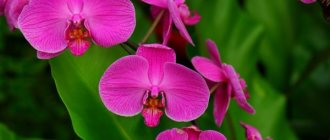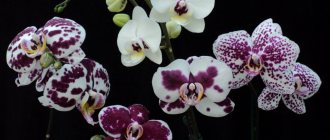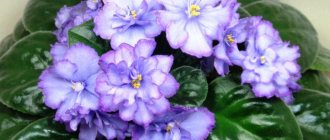Hydrogel is a polymer that most often looks like small multi-colored balls or large grains of sand ranging in size from three millimeters to two centimeters. Often, orchids are already planted in hydrogel in flower shops, but having purchased such a flower, you should transplant it into specialized soil as soon as possible. Because plants will not live long in this substrate.
Yes, hydrogel balls look very beautiful and original, and therefore the best use for them would be to decorate a flower that you plan to present to someone as a gift. To decorate your gift beautifully, just buy a beautiful transparent container, place a flower in it and fill it with hydrogel so that the flower is kept in the center. However, having given such a gift, it is necessary to inform the recipient that the plant must be replanted in soil intended specifically for it.
Hydrogel for orchids
Description of the drug
Growing an orchid in hydrogel: how does it happen and how to properly care for it? This is a polymer that can be seen on sale in the form of coarse sand or colored balls the size of peas. Its main feature is the active absorption of moisture , and then gradual release to the plant or atmosphere, if a flower is not planted in it.
Hydrogel beads absorb moisture and then gradually release it back.
The price of the drug depends on the packaging size and particle diameter. Starting price from 250 rub.
In the form of balls
For this purpose, balls ranging in size from 0.5 cm to 1.5 cm are sold. Sometimes you can see that the plant is already planted in such balls when sold, but as practice shows, the flower will not live .
Because there is practically no access to oxygen . But, if you want to plant it while presenting a flower gift, then take a container, put a flower in the center and fill the entire void with balls.
Advantages and disadvantages
Among the advantages: relative beauty when buying a flower, and among the disadvantages is that after a short time it will be compressed and will not give the root system access to oxygen. In addition, after a while the following appears:
- Mold on granules/balls;
- If a plant dies in this polymer, then it cannot be used for another flower, since it is not disinfected.
Types and properties of hydrogel, release forms
The drug has a second name “aquasoil”, which is used for growing flowers. It consists of polymer granules. The latter can retain water reserves for a long time, gradually releasing them to plants. For orchids, this characteristic of the hydrogel is very important, since it reacts sharply to both a lack and an excess of moisture.
Externally, aqua soil resembles gelatin balls bkb flakes of various shapes. They replace the soil mixture completely or add only a small part. The consistency of the balls is springy. They can be transparent or painted in various colors.
Release forms:
- Colorless - a soft substance added to the main substrate for an exotic flower.
- Colored – granular preparation. Orchids are planted in colored hydrogel to achieve greater decorativeness, since the nutritional capacity is much lower than that of the transparent type.
Features of cultivation
Sometimes you can see exotic beauties growing in colored polymer balls. It may be beautiful, but it is difficult for the plant to grow in it, since its roots are not adapted to such soil.
The root system of this plant is created in such a way that:
- Must participate in photosynthesis;
- And she must have access to oxygen.
Therefore, after several waterings, the polymer will be compressed and the air supply to the root mass will stop, the flower will lose its roots . The use of hydrogel beads can have a bad effect on the roots of the orchid.
How to use it correctly?
The polymer can only be used for resuscitation of orchids .
Some gardeners use hydrogel beads to resuscitate orchids.
Moreover, this experience does not help everyone and cannot be fully recommended, since it is not particularly confirmed by facts:
- A plant with leaves that have lost turgor is placed in polymer;
- And water it;
- They lie in this position for no more than 2 hours;
- After which they are cleaned of hydrogel.
Lifespan
will not grow in multi-colored polymer balls . Due to the lack of oxygen access to the root system, the plant will die from oxygen starvation. A month will be enough for it to turn from a beautiful plant into a bush without roots and with yellowing leaf plates.
IMPORTANT! If you receive a gift and the flower is in hydrogel, you must urgently save it with a complete transplant.
From seeds - reality or myth?
Is it possible to grow orchid seeds in hydrogel? Some flower lovers try to grow a flower from seeds. In addition, you can note that seeds will not grow in ordinary peat; they will die there almost immediately .
This happens because the seed of a tropical plant does not have a nutritious shell and therefore, in its native environment, the seeds germinate together with fungi.
The seeds are very small and the human eye cannot see them. One seed capsule contains many small seeds . Therefore, in order for a gardener to start propagating a plant using seeds, he must arm himself with a special composition in which to sow these midgets.
Some websites advertise hydrogel . But the seeds will not germinate in it, since it is a lifeless, not nutritious product that will not be able to feed the seedlings. Therefore, it is not used for germinating orchid seeds.
Seeds need a nutrient medium rich in sucrose and other nutrients so that the hatched sprouts can grow further .
Advantages and disadvantages
Hydrogel mixed with natural soil has virtually no disadvantages. This mix is often used by flower growers. The advantages of hydrogel added to the soil include:
Blueberries for growing at home at a competitive price (advertising)
- excellent absorption of excess moisture, which prevents rotting of the root system of the flower, due to the absence of stagnation of liquid in the soil;
- long-term retention of moisture, up to a month, which helps to moisturize the roots of the plant in case of lack of liquid;
- good loosening of the soil, facilitating the penetration of oxygen and nutrition into the soil mixture to the root system of the flower.
But all the same, orchids grown in such an artificial substrate will face inevitable death.
Reviews
Many buyers leave their reviews about hydrogel for orchids: some are positive, and some are negative. Here are some of them.
Nina Petrovna, Sevastopol. “I bought these beautiful balls for cultivating orchids. But having tried them, I do not recommend the polymer for growing any plants. They refuse to grow in this artificial environment. Balloons can only be used as decoration."
Svetlana, Omsk. “I bought this polymer to grow Vanda. But I didn’t put her in it directly. I have a tall, straight vase 50 cm high. I put balls on the bottom and moistened them. And on top there is a flower.
Each person uses hydrogel beads differently.
That is, between the hydrogel and the roots there is about 30 cm of moist air. This is how a flower grows. As soon as the roots grow into balls, it will be necessary to increase the height of the vase.”
Alena, Ryazan. “I bought myself a polymer in order to revive an orchid, but it completely destroyed it. But adding it to the soil when growing hibiscus, I discovered that the soil retains moisture longer and the flower does well. But I don’t recommend cultivating orchids in this polymer.”
In what cases can hydrogel be used?
Despite all the harm that hydrogel can cause to orchids, these balls are extremely necessary when the flower is already dying. They are able to revive him.
But this method should not be used by inexperienced gardeners, because there is a high chance of completely ruining the plant. If a flower has lost the former elasticity of its tissues, then you can revive it as follows: place the foliage of the plant in a container and fill it with hydrogel, and then fill it with soft, purified water. The flower must be kept in this state for no more than three hours, after which it must be returned to the container with organic soil.
Japanese strawberries for 147 rubles for growing at home (advertising)
Transfer
Is it possible to plant an orchid in hydrogel? Sometimes in flower shops you can see orchid seedlings for sale, planted in polymer . What is this for?
Necessity
There is no need to replant the flower at all, since there is no way for it to grow roots. Therefore, the best solution for the plant would be to plant it in normal bark . This will allow it to live normally and grow roots for subsequent leaf growth and flowering.
How to grow orchids at home from a bottle, bulb, flower - care with photos
How to grow orchids at home
This exotic plant appeared to me quite recently, but before its appearance I had never dreamed of such happiness. For some reason it seemed to me that this miracle was finicky and capricious, but it turns out I was wrong. And in this article you will learn about growing orchids at home, I will briefly talk about growing orchids from a bulb, a bottle, whether it is possible to grow an orchid from a flower, and I will touch a little on the topic of care. I will try to share my experience with you, I hope it will help you train this beauty.
Unfortunately, one article cannot tell you about all the subtleties and tricks, so if I missed something, I hope for your understanding. In any case, on this site you can find other articles where the information is given in more detail.
There are many species of orchids and each of them has its own advantages and disadvantages and care, and growing conditions differ in many respects for each species individually. In this article you will find general recommendations suitable for any type of orchid.
Proper cultivation of orchids at home
Any indoor plant needs good care. Orchids are no exception, but growing this plant differs in many ways from growing other indoor plants.
There are a huge number of types of orchids and each type needs a certain type of care. Some orchids love warmth, others cool, and others need high humidity. There are also varieties that cannot be grown at home.
Despite the fact that each species has its own requirements for growing conditions, they have general care requirements. For example, orchids are epiphytes and, unlike other indoor plants, they cannot live in ordinary soil. And in nature, growing orchids generally occurs without a substrate. And if you neglect this rule and plant it in an ordinary, albeit nutritious, substrate, then your beauty will die within a few days.
How to grow orchids at home
Successful orchid growing depends on maintaining a balance. For example, if the room is too hot, then care should be taken to increase air humidity and increase watering.
But in cloudy, cool weather with short daylight hours, reduce watering and lower the temperature in the room.
When the orchid enters a period of rest, watering is reduced and additional nutrients are stopped.
Unfortunately, after purchase, an expensive and beautiful orchid may die and there may be several reasons for this, all of which are related to improper cultivation of the orchid at home.
Unfavorable conditions for growing orchids at home
- The room is too hot
Unfortunately, in modern apartments the indoors are too hot. And you will make an unforgivable mistake if you place your beauty near the battery. During this period of time, most orchids enter a period of rest and if cool conditions are not created for it, the plant may die.
- Incorrect spraying
Some types of orchids are demanding on air humidity. But despite this, try to spray the plant in the first half of the day. If droplets of water remain on the leaves of a plant overnight, the plant may rot.
- The enemy of successfully growing orchids is overwatering.
This is a mistake many newbies make. But in this case it is better to follow the rule: it is better to underfill than to overfill.
- The enemy of the orchid is the bright sun
Even though orchids love light, direct sunlight can be harmful to them. In the summer, you need to try to shade the plant and prevent direct sunlight from hitting the leaves.
How to grow orchids at home
- We observe the temperature regime
If you want to avoid unpleasant hassle, then when buying an orchid, choose varieties that can be grown in our apartment conditions.
There are varieties that require cold conditions at night and warm conditions during the day. Unfortunately, this is difficult to do, therefore, give preference to types of orchids that favorably tolerate a temperature difference between day and night of no more than 5C.
The phalaenopsis orchid is most suitable for our apartments.
- When growing an orchid, water it correctly
For many gardeners, especially beginners, watering is a sore subject. Many beginners water their plants almost every day, both in winter and summer. While other plants can survive from excessive watering, orchids are very sensitive to waterlogging.
How to grow orchids at home
Due to frequent watering, the orchid's roots begin to rot, which, due to waterlogging, do not receive air. Worldwide, overwatering is the #1 cause of orchid death. Unfortunately, you won’t immediately notice from the plant that it has started to have health problems.
If the leaves of other plants begin to turn yellow, turn black, or rot due to overwatering, then the orchid may look healthy for a long time. But unlike other plants, the orchid needs time to recover. Sometimes it takes several years to recover.
- Lighting when growing orchids
Lighting plays a huge role in growing orchids. After all, in light, most vital processes occur in a plant. And no matter what type of orchid you grow, it is important to provide it with light for 12-16 hours.
Lighting intensity also plays a big role. Of course, the intensity of lighting depends on the type of orchid, but despite this, the light requirement of an orchid is an order of magnitude higher than that of other indoor flowers. Most orchids that live in our homes do not have enough light.
Since the phalaenopsis orchid is most suitable for our conditions, we can say that this variety is shade-tolerant. Phalaenopsis can be placed not on the windowsill, but next to the window. You can place the flower anywhere in the room and illuminate it with fluorescent lamps.
Growing orchids from a bottle
If you are going to travel to Thailand, be sure to buy yourself a bottle of orchids. Well, if you have already brought such a souvenir and are now wondering what to do with it, then let's talk about growing an orchid from a bottle.
How to grow orchids at home
When I was looking for information about such orchids, many people wrote that it is very difficult for bottle orchids to take root here. But despite this, there were also good reviews where people showed their young orchids. Someone even made a video about their orchids, talking about each variety.
In Thailand you can buy a wide variety of orchids this way. This is a very inexpensive way to breed this beauty.
So, you came home from vacation and brought with you a souvenir dear to your heart, or maybe it was given to you. Now just set it up and let the little ones grow quietly for a while.
Firstly, moving is really stressful for plants and it will take them 3-4 weeks to get used to it. If you do not give them time to adapt, the young seedlings will simply die. And secondly, all the conditions have been created in bottles for plants, thanks to which plants can live like this for a long time. Therefore, if the babies are very tiny, then leave them in the bottle and let them grow a little.
When you notice that the babies have grown and they do not have enough space in the bottle, you can start replanting them.
To replant, you will need damp newspapers and a hammer to remove the plants. We wrap a bottle of orchids in newspaper and break the bottle. Try not to hit too hard so as not to crush the plants themselves.
When you remove the tiny orchids, inspect them carefully for signs of mold, then wash the leaves and roots. It is not worth extracting the jelly-like mass from the roots, since it will still contain the nutrients that the plant needs at first.
How to grow orchids at home
Now take small pots, you can replace them with disposable plastic cups by making holes in the bottom. We carefully place the roots in a glass and sprinkle them with a special substrate, trying to fill all the empty space.
When we are done with transplanting the babies, we put them in a bright place, but make sure that they are not exposed to direct sunlight. You can keep the plants in the greenhouse for some time. Further care consists of regular watering.
Growing an orchid from a bulba
If you have a mature, overgrown orchid that needs to be divided, this is a great way to get a new plant.
Before separating the bulb, remove the plant from the pot, remove all substrate from the roots, cut off all dry and diseased roots.
At the junction of the bulbs, cut with a sharp knife. All bad roots need to be removed from new bulbs. Now soak the bulbs in any disinfectant solution - this will help get rid of pathogenic bacteria.
Pour wet soil into any transparent bag and place the buluba in it. To retain moisture, the bag can be tied. Place the packages in a place where no one will touch them.
After about 3-4 months, the bulbs should sprout roots - this means that they can now be planted in separate pots.
Orchids. Those grown from bulbs begin to bloom after 2 years.
Growing orchids in hydrogel without substrate
How to grow orchids at home
Recently, I often notice orchids that grow not in a substrate, but in a beautiful glass vase with transparent balls without soil. Undoubtedly, it is very beautiful, but, unfortunately, the advantages end there.
The thing is that orchids have a special structure of the root system and they need air for normal development. When buying an orchid in hydrogel, remember that it will not live long. So don’t be fooled by advertising calls that hydrogel is cool, it has a lot of advantages and all that.
How to grow an orchid from a flower
In fact, there is no such method in any book about orchids (at least in the books that I have). But while trying to find information on this matter, I found on some flower forums how some people boasted that they managed to grow an orchid from a flower, that is, from a peduncle.
To do this, you need to cut the peduncle and place it in a vase with water. After about 3-4 weeks, a baby appears on the peduncle.
How to grow orchids at home
I don’t know how possible this is; I haven’t used this method myself. I kind of feel sorry for cutting beautiful orchid flowers, because I don’t know whether they will let children in or not, but they can delight you with their beautiful flowers for several months.
Personally, I am not ready for such experiments. If you, my dear readers, have tried this method, I will be glad if you tell me about it.
There is a second way to grow orchids from flowers. To do this, we cut off the peduncle when flowering has already ended. We cut it into several parts and treat the cut areas with crushed activated carbon.
We place the cuttings in the substrate and create greenhouse conditions (cover with oilcloth). After 2-3 weeks, the cuttings should have roots.
Orchid growing and care video
Possible consequences
If the flower was purchased planted in polymer, then most likely, if you take it out from there, you may not find the roots .
Growing an orchid in hydrogel balls can lead to the death of the roots.
Because after a month without access to oxygen, they begin to die off almost all at once. The result will be a disastrous result: the death of the beauty if the absence of roots is not detected in time.
IMPORTANT! Having received such a surprise as a gift, the flower must be urgently transplanted into a normal substrate. Beauty is beauty, but do not forget that the flower wants to live.
How does it affect development?
After a month of living in hydrogel balls on an orchid, you can notice an “amazing” result :
- Loss of root mass;
- Leaf blades that have lost turgor;
- If there was flowering, then the flowers withered ahead of schedule.
In what cases is it justified?
An adult orchid can be planted in a transparent container filled with beautiful hydrogel balls, if you want to give a unique gift , but you should warn the owner of the gift that transplantation into the bark will be required.
Beautiful hydrogel beads are simply an attractive design technique for the florist , and not a decision about the choice of soil.
Category: “Questions and answers”
Question No. 1. Is it possible to plant orchids in dry hydrogel, without soaking?
Answer.
Not worth it! The granules increase greatly in size and can break the roots of the plant. Then, instead of the expected benefit, the orchid can be destroyed.
Question number 2 . Which aqua soil is better for orchids – transparent or colored?
Answer.
Both are good. Transparent is often mixed with a nutrient substrate. If the main goal is decoration, then painted figures are used.
Question number 3 . How long can you keep orchids in aqua soil?
Answer.
On average 2 years. As a rule, this is the period before a planned transplant. Fresh hydrogel is placed in a new pot and the old one is thrown away.
Aqua soils and hydrogels
Aqua soil is a polymer synthetic material produced in various configurations: it is intended for decorating flowerpots, soils, aquariums or garden plantings.
Aqua soil is not recommended for use as a substrate for plants, especially for plants as fragile as orchids.
Hydrogel is a high-tech structure created artificially as a result of many years of research and testing conducted by the best physicists, chemists, technologists and agronomists.
The hydrogel is capable of absorbing an amount of water hundreds of times greater than its weight, after which it gradually releases this liquid to the plant. At the same time, it does not create conditions for the development of pathogenic microorganisms, does not acidify the environment, and does not release substances harmful to plants.











